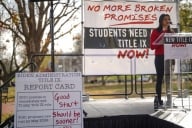You have /5 articles left.
Sign up for a free account or log in.
The Princeton University Press cannot give away the ending of its forthcoming book on the 2012 presidential election. But it does plan to give away the beginning.
The press has a novel approach to marketing The Gamble — a forthcoming book by political scientists John Sides of George Washington University and Lynn Vavreck of the University of California at Los Angeles that intends to bring a data-intensive, social science perspective to the upcoming campaign showdown between Barack Obama and Mitt Romney. The Princeton press is planning to make the first two chapters of the book available in electronic form, at no cost, in time for the national party conventions at the end of the summer.
“One of the challenges of university press publishing is our [timetable], because the reviewing process can be a little longer,” says Chuck Myers, the executive editor for political science, law and American history at the press. “We’re trying to find ways of getting books about contemporary issues out faster.”
This is the first time the press has made chapters of one of its titles available prior to publication of the whole work. Princeton, along with many of university presses, have embraced digital “shorts” — chapters or small chunks of published books — as a way to entice buyers who might not think it worthwhile to purchase the whole work. But doling out electronic nuggets of a forthcoming book in advance is a new strategy that Princeton hopes will insinuate into the national election narrative a take that is both academic and timely.
The Princeton press is hoping that by making the initial chapters of The Gamble — the first, an exposition of the political landscape in the run-up to the election; the second, an account of the Republican primary battles — available as the race is still unfolding, the press and its authors will be able to help shape the narrative of the election as it is happening rather than merely providing hindsight after the fact.
“This is an effort to be proactive,” says Myers, "to take the analysis of really smart scholars and make it part of the discussion as the election campaign is unfolding.”
Journalists do a good job covering day-to-day storylines of the campaign trail, but social scientists are trained to bring a level of analytical rigor that transcends the daily dramas of the news cycle, says Sides, one of the book’s co-authors. Unfortunately, they tend to work more slowly, he says. And the peer-review process applied by university presses generally delays the publication of academic analysis until after it has become, well, academic.
In this case, Myers secured permission from the Princeton press’s editorial board to have the first chapters peer-reviewed on truncated timetables — 2 to 3 weeks rather than the typical 3 to 4 months — and published to coincide with the election cycle. The plan is to publish the first two chapters by the end of August, the second two chapters in October or November, and the final, finished edition of the book (in print and electronic format) in spring of next year.
It’s a strategic approach — designed to create hype for the book while contributing a social science-tinged backdrop to the horse race coverage, Myers explains. “The idea behind this is this will build buzz and conversation that will benefit the book when we publish it as a whole,” he says.
Myers said that while casual news readers will probably still rely on newspaper and magazine accounts, he hopes Sides and Vavreck’s take will at least shape the thinking of the reporters who are writing those stories.
At the same time, the accelerated publication schedule will challenge the authors by bringing their deadlines more closely into line with mainstream writers, says Sides.
One of the challenges of elevating the analysis above the level of instant-punditry is taking the time to figure out exactly what the data are saying, he says. And sometimes a trenchant interpretation takes a while to gestate. “It’s not a lot different from any kind of science project — where you spend time stumbling around blind alleys, investigating a hypothesis that didn’t turn out to be true,” says Sides.
“By working quickly we have less time to really work on that,” he continues. “And yeah, it raises the possibility that could we make a mistake. Certainly that’s something we need to be considerate of.”
For now, the e-chapter advances are an experiment rather than a full-on strategic turn. If the experiment is successful, the Princeton press might try doing the same on similarly timely topics, such as war, says Myers. But he is not certain what it could portend for the disaggregation of university press content in general. In this case, the e-chapters will probably cease to be available once “The Gamble” comes out in full form, Myers says.
One of the possible hazards of breaking apart academic press books and selling them chapter-by-chapter, like songs in iTunes, is damaging the sales of the full books, says Jennifer Crewe, associate director of the Columbia University Press.
It could prime readers to buy the full book, says Crewe, but it could just as easily persuade them not to — or slake their thirst just enough to make buying the rest of the book seem unnecessary.
Like the readers of the early chapters of The Gamble, Myers says the Princeton press expects to acquire perspective on the effects of this editorial Gamble in real time. “From my standpoint it is both an experiment in using new technology in virtually every stage of the creation of this book,” he says, “and also a bet on two authors I have a lot of confidence in.”
For the latest technology news and opinion from Inside Higher Ed, follow @IHEtech on Twitter.








